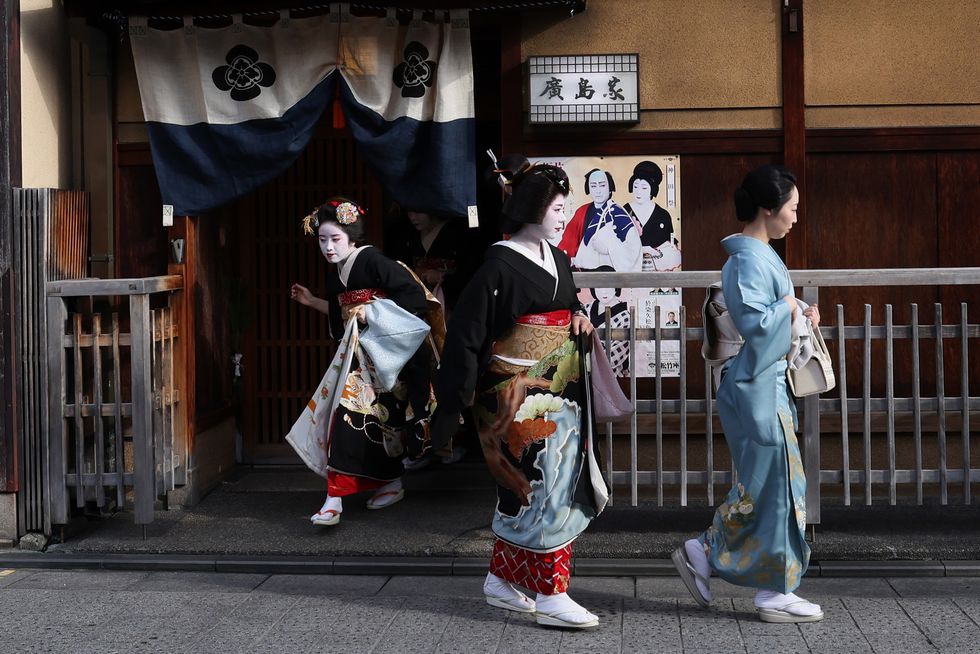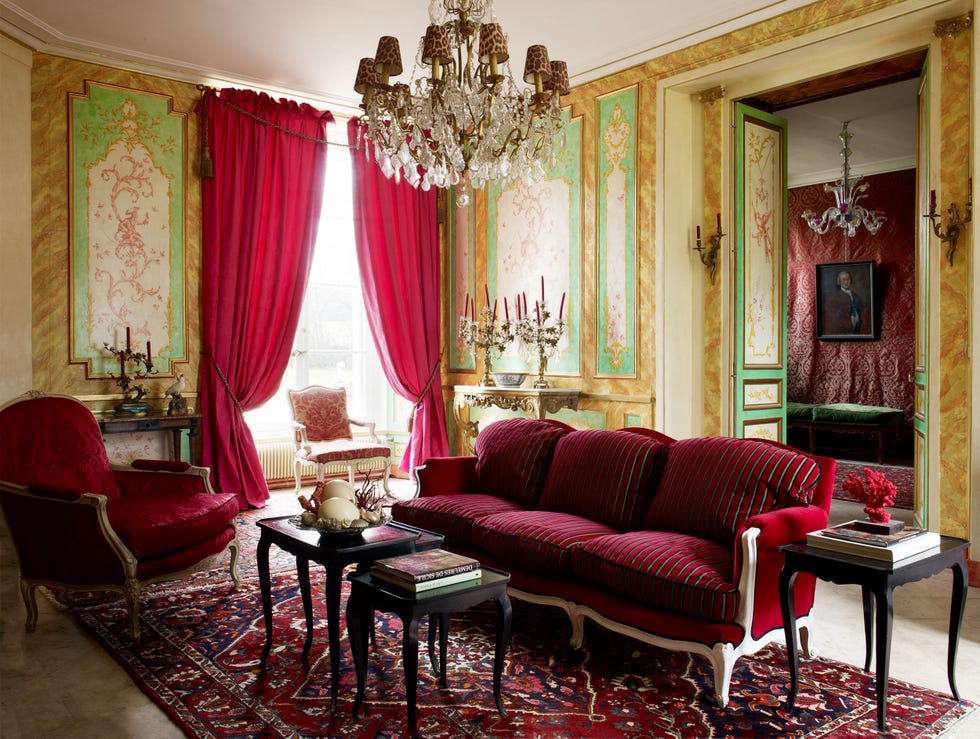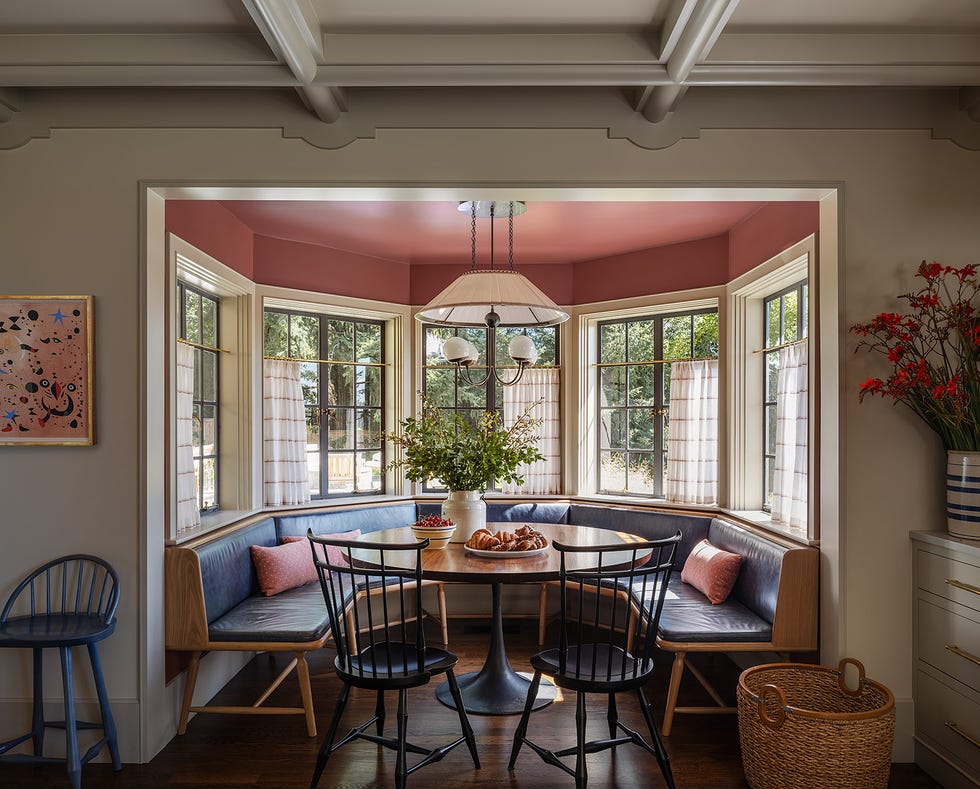There is a dream of Kyoto—saffron gates, cherry trees dripping with pink spring blossoms, centuries-old purveyors of soba and matcha, and geishas slipping around cobblestone corners—that has made this Japanese city one of the world’s most popular destinations. But Kyoto is not Venice. Arrive at the futuristic and bustling Kyoto train station (as many do on the high-speed Shinkansen train from Tokyo) and you realize that the former capital of Japan is not a theme park but a modern and evolving city—one with industry (Nintendo is based here), a university that has produced 19 Nobel Prize laureates, and increasingly, a creative class that is setting global trends in art, food, and design.
“For us Japanese, Kyoto has a special place in our hearts,” says Akari Endo-Gault, a curatorial consultant for Roman and Williams Guild. “The city has preserved its old traditions, its temples, crafts, and that real geisha world. It’s the most exquisite version that exists of old Japan.”
Founded in 794 as the seat of Japan’s imperial court, Kyoto remained the capital for over 1,000 years—a millennium in which everything from architecture to literature flourished. Religion did, too—there are over 2,000 Buddhist temples and Shinto shrines in Kyoto, including Sanjūsangen-dō, with its 1,001 statues of Kannon, the goddess of compassion, and Saiho-ji, where monks tend to an emerald garden carpeted with 120 varieties of pillowing moss.
Kyoto’s otherworldly beauty has made it the star in recent months of two high-profile fashion events. In April, at the peak of Sakura (cherry blossom) season, Dior sent its models down garden paths leading to the five-storied pagoda of To-ji Temple. Then, in early June, Chanel celebrated its new high jewelry line—think diamond winged brooches mixed with Japanese lacquer—at Shogunzuka Seiryuden, a temple perched on a mountaintop in Higashiyama.
“The human scale is grounding in Kyoto,” says Stephanie Goto, an ELLE Decor A-List architect who created the interiors for the restaurant Jean-Georges at the Shinmonzen, inside a Tadao Ando-designed Kyoto hotel. “You feel enveloped by centuries of culture and Japanese aesthetics, from a piece of confectionery to a tea house in the mountains.”
The rise of Kyoto as a top tourist destination does have a dark side: Some of the best-known attractions, from the bamboo forest to Gion, the geisha district, are so trampled they can be stressful to visit—it’s hardly a Zen experience. But it’s easy to take another, less trodden path: wander into one of the small neighborhood temples that appear all over the city, stroll along the urban park that borders the city’s Kamo River, or explore one of the quiet, residential neighborhoods with its traditional machiya-style townhouses adorned with flowers and plants.
Here is the best of Kyoto, whether your goal is to take in the sights, or explore the modern side of this perfectly preserved antique city.
WHERE TO STAY
SIX SENSES KYOTO
Opened in April 2024, this urban resort in downtown Kyoto is well situated near Gion and the Kyoto National Museum, but it feels like a world apart thanks to its thoughtful design by Singapore’s BLINK Design Group. The property’s 81 guest rooms and suites look inward onto a series of courtyard gardens, and feature design touches—from Washi paper partitions to Edo-style plasterwork—sourced in Kyoto. My favorite touch: the outside of every door has a papier-mâché sconce shaped like a fox, a beloved symbol in the city. Light indicates «please make up the room»—a clever detail.
BANYAN TREE HIGASHIYAMA KYOTO
Perched on a hill above the traditional Geisha district of Gion, the serene Banyan Tree—designed by Japanese architect Kengo Kuma—is another newcomer in Kyoto. It’s also the only hotel in town with its own stage for Noh performances, the traditional Japanese dramas that incorporate masks and dance, and a private bamboo forest. Leave your shoes at the door when entering one of the 52 guest rooms, each one outfitted with tatami mats and Hiba wood soaking tubs, and several with views overlooking Gion toward the mountains. In the evening, the hotel’s restaurant, Ryozen, features a multi-course Kaiseki menu with ingredients like wagyu, sea urchin and spiny lobster. Meanwhile the hotel’s onsen is fed by a natural hot spring.
AMAN KYOTO
This bucket-list hotel is the work of the Aman’s longtime architect, Kerry Hill, who died a year before it opened. The location—it’s in its own 72-acre garden near Kinkakuji temple (the Golden Pavilion)—is a bit remote but this tranquil resort is its own destination, a place where architecture melds seamlessly with nature.
ACE HOTEL KYOTO
Commune, the ELLE Decor A-List firm based in Los Angeles, designed the interiors of Japan’s first Ace Hotel. Located in a former 1920s telephone company building, architect Kengo Kuma renovated and expanded the space. While far from traditional, the Ace taps into a newer Kyoto zeitgeist, from the Japanese-style photo booth in the lobby to the local DJs who spin records here on Saturday nights.
HOTEL THE MITSUI KYOTO
Near the 17th-century shogun’s palace, Nijo Castle, Hotel the Mitsui Kyoto is a collaboration between Japanese architect Akira Kuryu and Hong Kong interior designer André Fu. The lobby overlooks a Japanese garden with a weeping cherry tree, while private onsen baths are supplied by a natural hot spring that runs beneath the hotel.
WHAT TO SEE
KATSURA IMPERIAL VILLA
When the 17th century Prince Hachijo Toshihito built a villa and garden inspired by the iconic Japanese novel, The Tale of Genji—complete with a teahouse, garden, and venues for moon watching—he had no way of anticipating that his masterpiece would become a touchstone for 20th and 21st century architects, from Le Corbusier to Tadao Ando. The strolling garden leads from one pavilion to the next, each one an object lesson in minimalism, simplicity and flexibility, all framed by views of nature. As the Bauhaus architect Walter Gropius exclaimed: “Katsura Villa is a revelation!” The reservation process, though, is an act in cultivating patience: Visitors have to apply online to the “Imperial Household Agency” three months in advance, and wait to be accepted “by lottery.” Bring your passport to the gate.
SAIHO-JI (KOKE-DERA) TEMPLE
A visit to Kyoto’s legendary “moss temple” requires a paradigm shift. Visitors are first escorted into a temple where they are handed a calligraphy pen and passages of a sutra, or Buddhist teaching, which they are asked to copy “to calm the mind.” The activity, which takes about 15 minutes, puts you in the right mood to view the garden, a UNESCO World Heritage Site where monks tend a fairytale landscape in which verdant moss surrounds a pond shaped like the Chinese character for “heart.” Visiting the garden also requires planning ahead—fortunately one can now book online in addition to the previous method: by postcard.
KAWAI KANJIRO’S HOUSE
The late ceramic artist Kawai Kanjiro was a driving force in mingei, the influential Japanese folk art movement of the 1920s and ‘30s that celebrated the beauty of everyday objects. His Kyoto house and studio, which he built in 1937 with the help of his carpenter brother, has been preserved by his family as a museum. The rooms remain almost as he left them—with the antiques and art he collected and his own vases not behind glass, but on display and filled with fresh flowers. There is even a cat on the windowsill. You can also tour his studio and see the amazing climbing kiln where he and his contemporaries fired their lovely work.
PHILOSOPHER’S PATH
Far from the crowds, the charmingly named Philosopher’s Path is a pedestrian walk alongside a canal framed with cherry trees. Endo-Gaut recalls walking the path as a child with her father in search of the traditional tofu restaurants that have long been based here. The path, named for a pair of 20th century philosophy professors who used to stroll here and debate life’s big questions, has become a locus of the new Kyoto, with nearby small gourmet restaurants like Monk and Farmoon and galleries like Robert Yellin Yakimono, which specializes in ceramics. For a great walk, start at Ginkaku-ji—the “silver” pavilion known for its Zen sand garden and amazing views—then stroll along the Philosopher’s Path until it ends at another temple, Nanzen-ji.
WHERE TO EAT
NISHIKI MARKET
For food and, frankly, spectacle, everyone heads to Nishiki Market, the over four-century-old arcade that spans six blocks in the city’s downtown. Under a colored glass roof, and lit by lanterns and light bulbs, the market offers a taste of every Japanese gourmet delight you can imagine—sushi, tiny grilled octopus on a stick, every flavor of freshly-made mochi, soy milk doughnuts, and pickles. It’s also a go-to for gifts like chopsticks and ceramics, not to mention hand-forged steel knives at the iconic cutlery shop, Aritsugu.
FARMOON
In an antique machiya house, Masayo Funakoshi is creating a culinary experience like no other. The Tokyo-born chef, who studied sculpture at New York’s Pratt Institute before working at restaurants like Blue Hill, invites a handful of guests into her open kitchen at Farmoon each night, where she and her all-female staff create art on a plate. Everything comes with a story, from the cedar water that starts the meal, to the homemade chili oil with fermented soybean from a temple that’s been making it for centuries. The showstopper of a recent meal was a carrot carpaccio—with orange vinaigrette, shiso leaf and foraged ferns—that resembled stained glass. Be warned: Dinner guests must be referred by a friend of the restaurant. Ask your acquaintances for an introduction, or stop by for tea and cake on weekend afternoons, when the restaurant is open to all.
BADU
The Netflix series Chef’s Table in 2022 introduced the world to Monk, a 14-seat restaurant on Kyoto’s Philosopher’s Path that serves pizza in a kaiseki-style dinner. Last spring, Monk’s chef Yoshihoro Imai quietly opened a new restaurant in the area—Badu, helmed by a pair of chefs formerly of Monk. There is no pizza but the more casual, izakaya-style menu features seasonal vegetable-forward ingredients cooked over a charcoal fire. The minimalist design, in a 112-year-old house with a courtyard garden, is by Teruhiro Yanagihara Studio.
KISSATEN (COFFEE SHOPS)
Kissaten are to Japan what diners are to New York City—rooms with preserved-in-amber decor where you can get a cup of coffee and a casual meal. Dating to the Showa era (1926-89), Kyoto’s best kissaten are retro time capsules, often on a theme. Near Nijo Castle, Café Tyrol is like a trip to the Alps—complete with kissaten favorites like Japanese curry lunches and egg sandwiches. Salon de thé Francois, established in 1934, has stained-glass windows, an interior inspired by an ocean liner, and a menu of cakes and puddings. Near Sanjūsangen-dō Temple is Café Amazon Kyoto, where locals have been ordering hamburger steak, waffles and the restaurant’s own home-roasted coffee since 1972.
ISO STAND
When Noma’s René Redzepi was in town for his popup restaurant at the Ace Hotel, he and his team would spend free nights at this izakaya in Sanjo. Sit at the counter alongside fashionable locals and watch the young staff prepare claypot chicken, karaage (fried chicken), and plates of Japanese pickles, and wash it down with sake or natural wine.
WHERE TO SHOP
IPPODO TEA KYOTO MAIN STORE
It’s hard to imagine a more atmospheric tea shop than Ippodo’s over 300-year-old original location, from the noren curtains that shade the entrance to the interior, with its wooden shelves, brown glazed tea jars, and tatami mats. Their superior, ceremonial-grade matcha (from the nearby town of Uji) is rationed: one per customer. But after a free tasting, you’ll fall in love with the wide variety of green teas, including sencha and roasted hojicha. There is also a tearoom where freshly brewed teas are paired with Japanese sweets. The shop is on Teramachi Street, a great location for antique shops and galleries like Yamahon, which hosts exhibitions of objects like sake vessels and bamboo craft.
HOSOO
Kyoto-based kimono purveyor Hosoo, founded in 1688, has branched into luxury home textiles. Earlier this year, they collaborated with Dimorestudio on a textile collection, exhibited at Milan Design Week, based on antique obi patterns. The family’s 12th-generation owner, Masataka Hosoo, enlisted his architect brother, Naohisa Hosoo, in 2022 to design the brand’s gorgeous new Kyoto flagship, a minimalist space with rammed-earth walls and a tea salon on the ground level. The third floor houses a private kimono salon with a collection of 7,000 garments.
MARCOURT SANJOTEN
This fashion brand offers minimalist made-in-Japan fashions in natural fabrics: Think ruffled details, cocoon dresses, and diaphanous blouses. Go if only to see the brand’s shop, a former wood-framed clock store built in 1890, during the Meiji period, that retains its original tiling, spiral stair, and vault. The neighborhood, Sanjoten, is known for its hip izakaya restaurants, vintage shops, and fashion boutiques—Kapital and 45R are nearby.
TOKINOHA CERAMIC STUDIO
Daisuke Kiyomizu, descendant of a famed family of Kyoto potters, studied architecture before switching to ceramics. With his wife Tomoe, who oversees the glazes, he creates ceramics in their Yamashina Ward studio that are beautiful but deliberately utilitarian—they are designed to be paired with food. A shop on the main floor offers everything from bowls to wall vases, while Tokinoha’s expanding library of collaborations with restaurants, including Quince in San Francisco, are on view in a gallery on the top level. (My visit was organized by Nishizawa Stay, a travel company that lets visitors spend time with prominent Kyoto residents, from a monk to a former geiko.)
EXCURSIONS
NARA
Just over an hour by train, Nara is an easy day trip from Kyoto. The city was Japan’s first capital, established in 710, and is home to numerous historic sites including Todai-ji Temple, home to a 49-foot-tall Great Buddha, and Kasuga-Taisha, a Shinto shrine known for its bronze lanterns. The biggest draw is Nara’s population of wild sika deer, tame creatures that are considered sacred and that bow to visitors in exchange for crackers.
MOMIJI-YA
“Shinrin-yoku” is the Japanese practice of forest bathing, or spending time in nature, to relieve stress. Founded over a century ago, this ryokan is in the Takao region on the outskirts of Kyoto. The traditional rooms feature mattresses on tatami-mat floors. Guests are given yukata robes to wear to meals or to the private open-air onsen, where you can bathe in hot mineral spring water overlooking a mountain gorge covered with maple trees.
Ingrid Abramovitch, the Executive Editor at ELLE Decor, writes about design, architecture, renovation, and lifestyle, and is the author of several books on design including Restoring a House in the City.






















